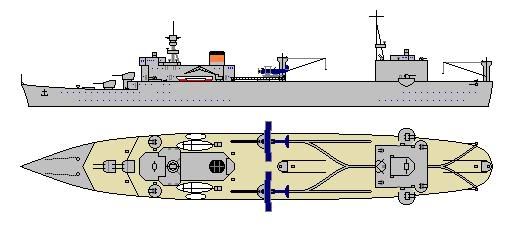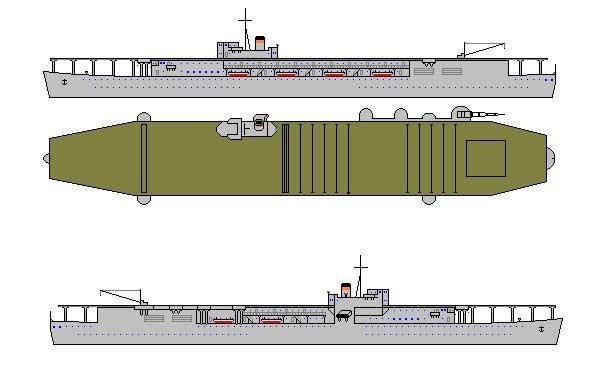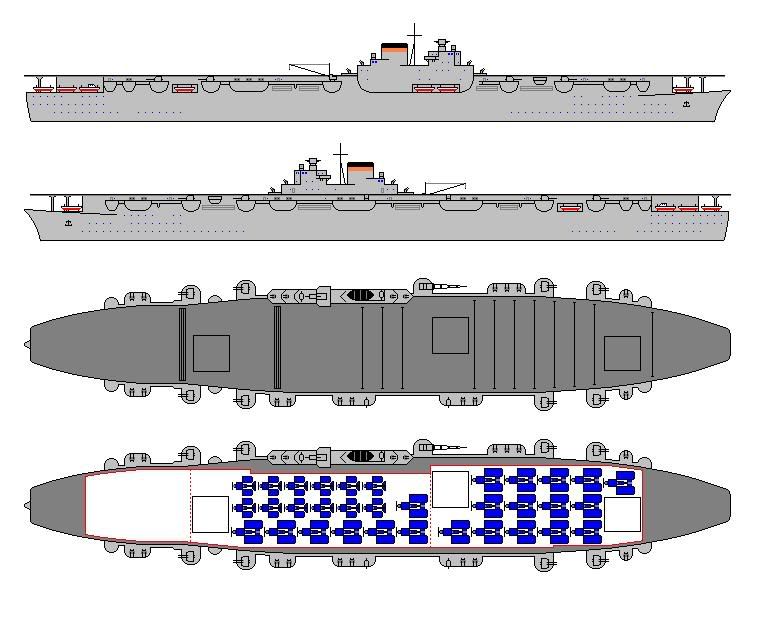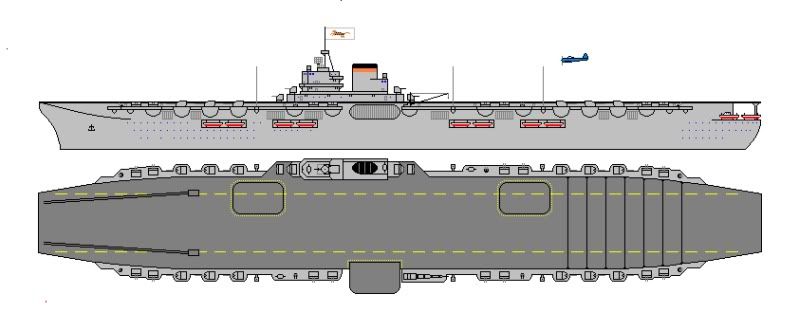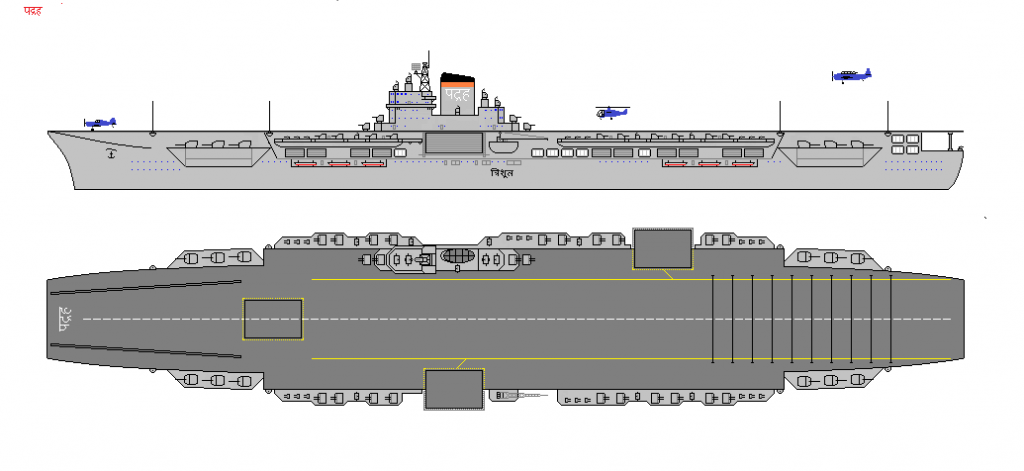[SIZE=3]Urumi Class Aircraft Carrier[/SIZE]
Urumi, CV-3, laid down 1925, refit 1939
Bichawa (ex-Sulu), CV-13, laid down 1927, acquired 1941, refit 1942
These ships were originally built as near-sisters for different navies. As early carriers, they were built to survive action against enemy scouting forces - hence carried a heavy gun armament and torpedos aft.
Urumi was Bharat's first carrier, and received a refit that extended her hanger and flight deck aft at the expense of the anti-surface battery.
Bichawa was laid down for the Philippines as Sulu and served until deemed surplus in 1941. The BNS acquired her and is undertaking a refit that will see her emerge functionally identical to Urumi. See the Filipino encyclopedia for details on her original configuration.
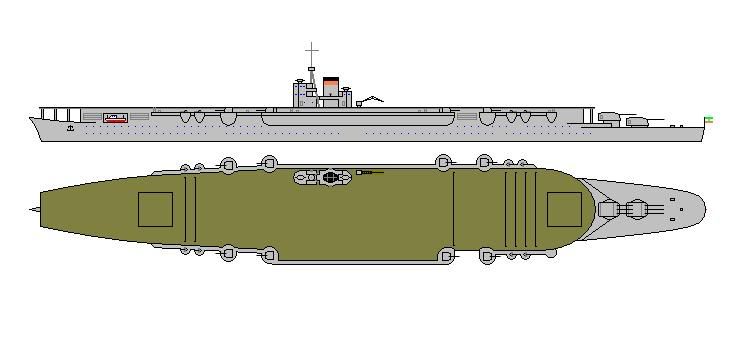
As Built...
As Refitted (both ships)
Displacement:
12,699 t light; 13,140 t standard; 14,625 t normal; 15,813 t full load
Dimensions: Length overall / water x beam x draught
676.04 ft / 665.85 ft x 74.11 ft x 20.34 ft (normal load)
206.06 m / 202.95 m x 22.59 m x 6.20 m
Armament:
20 - 4.13" / 105 mm guns (10x2 guns), 35.32lbs / 16.02kg shells, 1939 Model
Dual purpose guns in deck mounts with hoists
on centreline ends, evenly spread, all raised mounts - superfiring
6 - 1.38" / 35.0 mm guns (3x2 guns), 1.31lbs / 0.59kg shells, 1939 Model
Anti-aircraft guns in deck mounts
on side, all amidships, all raised mounts - superfiring
18 - 1.38" / 35.0 mm guns (6x3 guns), 1.31lbs / 0.59kg shells, 1939 Model
Anti-aircraft guns in deck mounts
on side, evenly spread, all raised mounts
8 - 0.59" / 15.0 mm guns (2x4 guns), 0.10lbs / 0.05kg shells, 1939 Model
Machine guns in deck mounts
on side, evenly spread
8 - 0.59" / 15.0 mm guns (6 mounts), 0.10lbs / 0.05kg shells, 1939 Model
Machine guns in deck mounts
on side, evenly spread
Weight of broadside 739 lbs / 335 kg
Shells per gun, main battery: 350
Armour:
- Belts: Width (max) Length (avg) Height (avg)
Main: 3.15" / 80 mm 419.95 ft / 128.00 m 10.66 ft / 3.25 m
Ends: Unarmoured
Upper: 1.97" / 50 mm 492.13 ft / 150.00 m 17.22 ft / 5.25 m
Main Belt covers 97% of normal length
- Gun armour: Face (max) Other gunhouse (avg) Barbette/hoist (max)
Main: 1.18" / 30 mm 0.59" / 15 mm 0.98" / 25 mm
2nd: 0.98" / 25 mm - -
3rd: 0.59" / 15 mm - -
4th: 0.59" / 15 mm - -
- Armour deck: 1.57" / 40 mm, Conning tower: 3.15" / 80 mm
Machinery:
Oil fired boilers, steam turbines,
Geared drive, 4 shafts, 107,539 shp / 80,224 Kw = 32.25 kts
Range 15,750nm at 12.00 kts
Bunker at max displacement = 2,673 tons
Complement:
664 - 864
Cost:
£5.124 million / $20.496 million
Distribution of weights at normal displacement:
Armament: 92 tons, 0.6%
Armour: 2,340 tons, 16.0%
- Belts: 1,283 tons, 8.8%
- Torpedo bulkhead: 0 tons, 0.0%
- Armament: 51 tons, 0.3%
- Armour Deck: 967 tons, 6.6%
- Conning Tower: 41 tons, 0.3%
Machinery: 2,981 tons, 20.4%
Hull, fittings & equipment: 4,886 tons, 33.4%
Fuel, ammunition & stores: 1,926 tons, 13.2%
Miscellaneous weights: 2,400 tons, 16.4%
Overall survivability and seakeeping ability:
Survivability (Non-critical penetrating hits needed to sink ship):
19,138 lbs / 8,681 Kg = 541.8 x 4.1 " / 105 mm shells or 2.2 torpedoes
Stability (Unstable if below 1.00): 1.21
Metacentric height 4.5 ft / 1.4 m
Roll period: 14.7 seconds
Steadiness - As gun platform (Average = 50 %): 54 %
- Recoil effect (Restricted arc if above 1.00): 0.09
Seaboat quality (Average = 1.00): 1.09
Hull form characteristics:
Hull has a flush deck
Block coefficient: 0.510
Length to Beam Ratio: 8.98 : 1
'Natural speed' for length: 25.80 kts
Power going to wave formation at top speed: 55 %
Trim (Max stability = 0, Max steadiness = 100): 50
Bow angle (Positive = bow angles forward): 20.00 degrees
Stern overhang: 1.00 ft / 0.30 m
Freeboard (% = measuring location as a percentage of overall length):
- Stem: 25.26 ft / 7.70 m
- Forecastle (27%): 22.74 ft / 6.93 m
- Mid (87%): 15.16 ft / 4.62 m
- Quarterdeck (10%): 15.16 ft / 4.62 m
- Stern: 15.16 ft / 4.62 m
- Average freeboard: 19.75 ft / 6.02 m
Ship tends to be wet forward
Ship space, strength and comments:
Space - Hull below water (magazines/engines, low = better): 92.7%
- Above water (accommodation/working, high = better): 178.7%
Waterplane Area: 33,180 Square feet or 3,083 Square metres
Displacement factor (Displacement / loading): 128%
Structure weight / hull surface area: 102 lbs/sq ft or 496 Kg/sq metre
Hull strength (Relative):
- Cross-sectional: 1.00
- Longitudinal: 1.00
- Overall: 1.00
Hull space for machinery, storage, compartmentation is adequate
Room for accommodation and workspaces is excellent
2025 tons = 45 planes
375 tons = Radar, Sonar, misc. stuff
As Built - Urumi
Urumi, CV-3, laid down 1925
Length, 203.0 m x Beam, 22.6 m x Depth, 6.2 m
14629 tonnes normal displacement (13030 tonnes standard)
Airgroup: 40 max; typically 16 fighters, 16 scout-bombers, 4 trainers
Main battery: 6 x 15.0-cm (2 x 3; 1 superfiring)
Secondary battery: 8 x 10.5-cm
AA battery: 8 x 3.5-cm
Light battery: 4 x 1.5-cm
Weight of broadside: 415 kg
4 TT, 50.0 cm (submerged, aft)
Main belt, 8.0 cm; ends unarmored
Upper belt, 8.0 cm (hanger sides)
Armor deck, average 5.0 cm
Conning tower, 8.0 cm
Battery armor:
Main, 10.0 cm / secondary, 5.0 cm shields
AA, 2.0 cm shields / light guns, 2.0 cm shields
Maximum speed for 78005 shaft kw = 32.01 knots
Approximate cruising radius, 15000 nm / 12 knots
Typical complement: 665-865
Estimated cost, $13.275 million (£3.319 million)
Remarks:
Superfiring turret is aft.
Main turrets are grouped together.
Relative extent of belt armor, 98 percent of 'typical' coverage.
Ship has slow, easy roll; a good, steady gun platform.
Ship is roomy, with superior accommodation and working space.
Distribution of weights:
Percent
normal
displacement:
Armament ......................... 114 tonnes = 1 pct
Armor, total ..................... 2438 tonnes = 17 pct
Belt 1015 tonnes = 7 pct
Deck 1145 tonnes = 8 pct
C.T. 41 tonnes = 0 pct
Armament 238 tonnes = 2 pct
Machinery ........................ 3394 tonnes = 23 pct
Hull and fittings; equipment ..... 5091 tonnes = 35 pct
Fuel, ammunition, stores ......... 1967 tonnes = 13 pct
Miscellaneous weights ............ 1625 tonnes = 11 pct
-----
14629 tonnes = 100 pct
Estimated metacentric height, 1.2 m
Displacement summary:
Light ship: 12662 tonnes
Standard displacement: 13030 tonnes
Normal service: 14629 tonnes
Full load: 15849 tonnes
Loading submergence 2946 tonnes/metre
+++++++++++++++++++++++++
Estimated overall survivability and seakeeping ability:
Relative margin of stability: 1.14
Shellfire needed to sink: 8089 kg = 172.4 x 15.0-cm shells
(Approximates weight of penetrating
shell hits needed to sink ship,
not counting critical hits)
Torpedoes needed to sink: 2.0
(Approximates number of 'typical'
torpedo hits needed to sink ship)
Relative steadiness as gun platform, 70 percent
(50 percent is 'average')
Relative rocking effect from firing to beam, 0.12
Relative quality as a seaboat: 1.09
+++++++++++++++++++++++++
Hull form characteristics:
Block coefficient: 0.51
Sharpness coefficient: 0.35
Hull speed coefficient 'M' = 8.33
'Natural speed' for length = 25.8 knots
Power going to wave formation
at top speed: 54 percent
Estimated hull characteristics and strength:
Relative underwater volume absorbed by
magazines and engineering spaces: 97 percent
Relative accommodation and working space: 177 percent
Displacement factor: 125 percent
(Displacement relative to loading factors)
Relative cross-sectional hull strength: 1.00
(Structure weight per square
metre of hull surface: 528 kg)
Relative longitudinal hull strength: 1.03
(for 6.00 m average freeboard;
freeboard adjustment +1.02 m)
Relative composite hull strength: 1.01
+++++++++++++++++++++++++
[Machine-readable parameters: Spring Style v. 1.2.1]
665.84 x 74.13 x 20.34; 19.68 -- Dimensions
0.51 -- Block coefficient
1925 -- Year laid down
32.01 / 15000 / 12.00; Oil-fired turbine or equivalent -- Speed / radius / cruise
1625 tons -- Miscellaneous weights
++++++++++
6 x 5.91; 2; 1 -- Main battery; turrets; superfiring
Central positioning of guns
Superfiring turret aft only
:
8 x 4.13; 0 -- Secondary battery; turrets
Gun-shields
:
8 x 1.38 -- Tertiary (QF/AA) battery
Gun-shields
:
4 x 0.59 -- Fourth (light) battery
4 / 4 / 19.69 -- TT / submerged / size
++++++++++
3.15 / 0.00 / 3.15 / 0.00; 98 -- Belt armor; relative extent
1.97 / 3.15 -- Deck / CT
3.94 / 1.97 / 0.79 / 0.79 -- Battery armor
(Note: For portability, values are stored in Anglo-American units)
+++++++++++++++++++++++++++++++++++++++++++++++++++++++
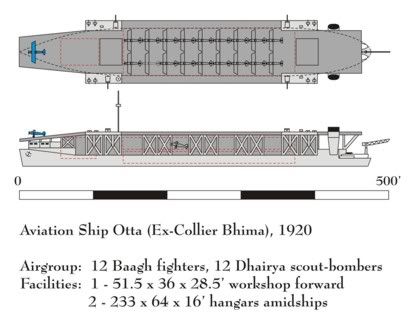

 As Built...
As Built...